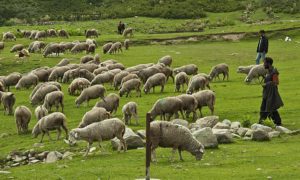Srinagar: Kashmir, one of the only two places in the world where Saffron grows will not be able to produce enough yield if the land, 13 kilometres away from Srinagar in Pampore is not irrigated on time.
In 2010, the government of India sanctioned Rs 371.18 Crore National Saffron Mission to help generate a good yield and prevent its decline. However, even 8 years later, the mission has not been accomplished.
With just 15 days left for the irrigation of the land, the authorities are busy playing the usual blame game.
Speaking about the issues faced by Saffron growers in the valley, Abdul Majeed Wani, President of Saffron Union told Free Press Kashmir that the yield of saffron is naturally low and that if the plants are not irrigated on time, the crop will be destroyed.
“A hundred Kg of fresh flowers yield about three Kilograms of (dehydrated) stigmas. We would traditionally water the land but after the government’s intervention, we stopped. Now, we do not know what we will do if they do not irrigate the land in September,” he said adding “Saffron flowers bloom for about three weeks from mid-October to the first days of November and the month of September is best to irrigate the land.”
However, nothing productive has happened since the scheme has been launched.
Saffron is an expensive fragrant edible plant that grows in autumn on thousands of canals in Kashmir. The orange stigmas of the purple saffron flower are harvested and used as a flavouring and colouring agent in various foods and traditional Kashmiri Kehwa.
There are four main departments involved in the Saffron mission: Sher-e-Kashmir University of Agricultural Sciences and Technology (SKAUST), the contractors, Mechanical Engineering Department (MED) and the Agricultural Department. All the four are at fault. However, all are shifting the blame on one another.
SKAUST officials claim to have proposed the idea of irrigating Saffron crops over thousands of canals of land in Kashmir using 109 bore wells initially.
As one passes through the Saffron fields, the borewells are visible and so are the water pipes which are inconveniently placed on the ground. Many pipes lie there unused and broken and SKAUST officials blame the “unaware farmers” for tying their cattle with the pipes.
ALSO READ: Kashmir loses 2200 hectares of saffron land in 2 decades
SKAUST proposed the technology and when asked as to why underground piping wasn’t proposed, the officials have no answers.
Moreover, they say that their part is limited only to developing the technology and not to check how it is implemented.
“We developed the technology. Rest, if they tie cattle to the pipes or other departments won’t work, that’s not our concern,” said a professor from SKAUST Research Centre Dussu, Pampore.
After proposing the idea, the Contractors involved in the mission were supposed to get the work done. However, they said that it took them time and efforts to make the villagers/farmers understand as to what they were doing.
“The villagers did not know why we were digging up wells and what the pipes were meant for. It was a hurdle in their traditional way of working. That is why they did not cooperate with us. We really had to face a hard time convincing them and winning their trust,” said Rakib, one of the Contractors.
On the other hand, the September 2014 floods and 2016 uprising in Kashmir were the reasons for the MED to miss the deadlines to run the bore wells.
“Now, we are ready with 60 wells and we did it at a fast pace but the Agricultural Department does not have the infrastructure to take over the wells that are ready to use because if they take it over, they will have to release the payments due,” said the engineers who are on strike till their funds are released.
Altaf Aijaz Andrabi, Director Agricultural Department told Free Press Kashmir that the department has already released the money and that the Chief Agricultural Officer, Pulwama, Mohammad Yousuf Shah is not releasing it.
ALSO READ: National Saffron Mission: Hold-up funds have brought us on verge of bankruptcy, say contractors
According to Shah, only 33 per cent of work has so far been done by MED.
Shah says he is not satisfied with the ‘5-minute testings’ of borewells and is asking the MED to schedule tests for months so they would be able to check the sustainability of the project completed so far.
“Until and unless the farmers and the Agricultural department are not satisfied with their work, we cannot release the money. They have missed many deadlines already and even after that, only 18 wells are ready for the handover. We want them to test the wells that are ready and eventually we will release their money,” said Shah.
“We can take over the wells only after they fulfil the standards. There are more than 50 segments that include hectares of land. We cannot rely on 5-minute testing. We have paid them the money in advance. Today, we do have MED’s money which is around 20 crores but it cannot be released without them doing the work. They do not come for testing. What if the project is not sustained? What if there is a flaw?” he added.
He also said that the Agricultural Department is ready to start the tests properly, release their money and irrigate the land. Asked if the Agricultural Department is not well equipped to take over the wells, Shah said, “That is not their concern. Let them finish their work. We are working on our part.”
While the departments continue to hold meetings and debates, the saffron growers are the ones who are going to incur the loss.
“We are really worried about the crops. The irrigation is due in September. The wells are ready. We need someone to operate the systems already installed. We cannot operate them on our own. In their blame game, we will incur huge losses. Is that what this Saffron mission was meant to do?” asked Wani urging the authorities to make a move towards the betterment of the Saffron growers.








